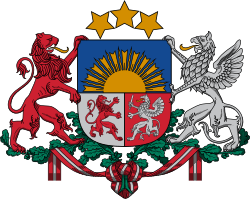You can help expand this article with text translated from the corresponding article in Belarusian. (March 2020) Click [show] for important translation instructions.
|
| |||||||||||||||||||||||||||||
All 201 seats in the Supreme Soviet 101 seats needed for a majority | |||||||||||||||||||||||||||||
This lists parties that won seats. See the complete results below.
| |||||||||||||||||||||||||||||
 |
|---|
Parliamentary elections were held in the Latvian SSR on 18 March 1990.[1] It was the first free parliamentary election in Latvia since 1931 and saw 201 deputies elected to the Supreme Soviet of the Latvian SSR, 170 of them in the first round. Run-off elections were held on 25 March 1 and 29 April. The Popular Front of Latvia won over two-thirds of the vote. Unlike its Estonian and Lithuanian counterparts, the Latvian Communist Party did not separate from the Communist Party of the Soviet Union. Nonetheless, on 3 May 1990, the new Supreme Soviet re-elected the Communist Party member Anatolijs Gorbunovs as its chairman, effectively the leader of Latvia. He subsequently resigned from the party, and a year later the Communist Party was banned by the parliament.
The elected parliament was responsible for some of the most important decisions in modern Latvian history, such as the declaration of renewed independence from the Soviet Union.
It was the first and only free election to the Supreme Soviet of Latvian SSR. The next parliament was elected as Saeima in 1993.[2]
Voting was held on the same day as municipal elections and elections in the Estonian SSR.
Results
[edit] | ||||
|---|---|---|---|---|
| Party | Votes | % | Seats | |
| Popular Front of Latvia | 1,086,439 | 68.20 | 131 | |
| Communist Party of Latvia | 342,499 | 21.50 | 55 | |
| Independents | 164,080 | 10.30 | 15 | |
| Total | 1,593,018 | 100.00 | 201 | |
| Registered voters/turnout | 1,960,638 | – | ||
| Source: Nohlen & Stöver | ||||
References
[edit]- ^ Dieter Nohlen & Philip Stöver (2010) Elections in Europe: A data handbook, p1122 ISBN 978-3-8329-5609-7
- ^ "Latvia – History". The World Guide. 17 November 2008. Archived from the original on 30 April 2003. Retrieved 18 November 2008.